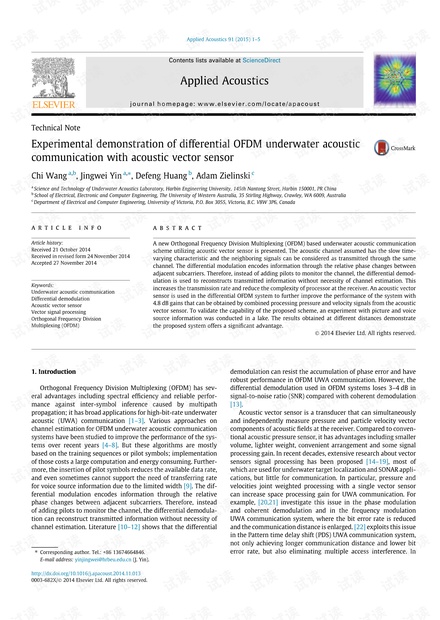
Technical Note
Experimental demonstration of differential OFDM underwater acoustic
communication with acoustic vector sensor
Chi Wang
a,b
, Jingwei Yin
a,
⇑
, Defeng Huang
b
, Adam Zielinski
c
a
Science and Technology of Underwater Acoustics Laboratory, Harbin Engineering University, 145th Nantong Street, Harbin 150001, PR China
b
School of Electrical, Electronic and Computer Engineering, The University of Western Australia, 35 Stirling Highway, Crawley, WA 6009, Australia
c
Department of Electrical and Computer Engineering, University of Victoria, P.O. Box 3055, Victoria, B.C. V8W 3P6, Canada
article info
Article history:
Received 21 October 2014
Received in revised form 24 November 2014
Accepted 27 November 2014
Keywords:
Underwater acoustic communication
Differential demodulation
Acoustic vector sensor
Vector signal processing
Orthogonal Frequency Division
Multiplexing (OFDM)
abstract
A new Orthogonal Frequency Division Multiplexing (OFDM) based underwater acoustic communication
scheme utilizing acoustic vector sensor is presented. The acoustic channel assumed has the slow time-
varying characteristic and the neighboring signals can be considered as transmitted through the same
channel. The differential modulation encodes information through the relative phase changes between
adjacent subcarriers. Therefore, instead of adding pilots to monitor the channel, the differential demod-
ulation is used to reconstructs transmitted information without necessity of channel estimation. This
increases the transmission rate and reduce the complexity of processor at the receiver. An acoustic vector
sensor is used in the differential OFDM system to further improve the performance of the system with
4.8 dB gains that can be obtained by combined processing pressure and velocity signals from the acoustic
vector sensor. To validate the capability of the proposed scheme, an experiment with picture and voice
source information was conducted in a lake. The results obtained at different distances demonstrate
the proposed system offers a significant advantage.
Ó 2014 Elsevier Ltd. All rights reserved.
1. Introduction
Orthogonal Frequency Division Multiplexing (OFDM) has sev-
eral advantages including spectral efficiency and reliable perfor-
mance against inter-symbol inference caused by multipath
propagation; it has broad applications for high-bit-rate underwater
acoustic (UWA) communication [1–3]. Various approaches on
channel estimation for OFDM underwater acoustic communication
systems have been studied to improve the performance of the sys-
tems over recent years [4–8]. But these algorithms are mostly
based on the training sequences or pilot symbols; implementation
of those costs a large computation and energy consuming. Further-
more, the insertion of pilot symbols reduces the available data rate,
and even sometimes cannot support the need of transferring rate
for voice source information due to the limited width [9]. The dif-
ferential modulation encodes information through the relative
phase changes between adjacent subcarriers. Therefore, instead
of adding pilots to monitor the channel, the differential demodula-
tion can reconstruct transmitted information without necessity of
channel estimation. Literature [10–12] shows that the differential
demodulation can resist the accumulation of phase error and have
robust performance in OFDM UWA communication. However, the
differential demodulation used in OFDM systems loses 3–4 dB in
signal-to-noise ratio (SNR) compared with coherent demodulation
[13].
Acoustic vector sensor is a transducer that can simultaneously
and independently measure pressure and particle velocity vector
components of acoustic fields at the receiver. Compared to conven-
tional acoustic pressure sensor, it has advantages including smaller
volume, lighter weight, convenient arrangement and some signal
processing gain. In recent decades, extensive research about vector
sensors signal processing has been proposed [14–19], most of
which are used for underwater target localization and SONAR appli-
cations, but little for communication. In particular, pressure and
velocities joint weighted processing with a single vector sensor
can increase space processing gain for UWA communication. For
example, [20,21] investigate this issue in the phase modulation
and coherent demodulation and in the frequency modulation
UWA communication system, where the bit error rate is reduced
and the communication distance is enlarged. [22] exploits this issue
in the Pattern time delay shift (PDS) UWA communication system,
not only achieving longer communication distance and lower bit
error rate, but also eliminating multiple access interference. In
http://dx.doi.org/10.1016/j.apacoust.2014.11.013
0003-682X/Ó 2014 Elsevier Ltd. All rights reserved.
⇑
Corresponding author. Tel.: +86 13674664846.
E-mail address: yinjingwei@hrbeu.edu.cn (J. Yin).
Applied Acoustics 91 (2015) 1–5
Contents lists available at ScienceDirect
Applied Acoustics
journal homepage: www.elsevier.com/locate/apacoust
















